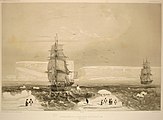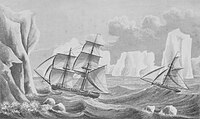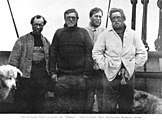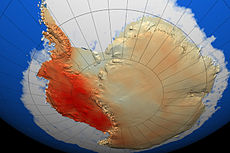User:HN016AQ/sandbox
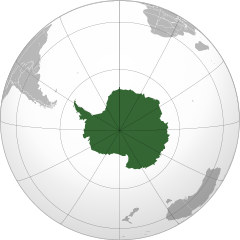 | |
| Area | 14,200,000 km²[1] 5,500,000 sq mi |
|---|---|
| Population | 1,000 to 5,000 (seasonal) |
| Population density | <0.01 per km² <0.01 per sq mi |
| Demonym | Antarctic |
| Internet TLD | .aq |
| Largest cities | |
| UN M49 code | 010 |
Antarctica (/ænˈtɑːrtɪkə/ or /ænˈtɑːrktɪkə/ ⓘ)[note 1] is Earth's southernmost continent. It contains the geographic South Pole and is situated in the Antarctic region of the Southern Hemisphere, almost entirely south of the Antarctic Circle, and is surrounded by the Southern Ocean. At 14,200,000 square kilometres (5,500,000 square miles), it is the fifth-largest continent and nearly twice the size of Australia. It is by far the least populated continent, with around 5,000 people in the summer and around 1,000 in the winter. About 98% of Antarctica is covered by ice that averages 1.9 km (1.2 mi; 6,200 ft) in thickness,[5] which extends to all but the McMurdo Dry Valleys and the northernmost reaches of the Antarctic Peninsula.[6]
Antarctica, on average, is the coldest, driest, and windiest continent, and has the highest average
Antarctica was the last region on Earth to be discovered, likely unseen until 1820 when
Antarctica is governed by parties to the
Etymology
The name Antarctica is the romanised version of the Greek compound word ἀνταρκτική (antarktiké), feminine of ἀνταρκτικός (antarktikós),[10] meaning "opposite to the Arctic", "opposite to the north".[11][12]
Aristotle wrote in his book Meteorology about an Antarctic region in c. 350 BC.[13] Marinus of Tyre reportedly used the name in his unpreserved world map from the 2nd century CE.[14] The Roman authors Hyginus and Apuleius (1–2 centuries CE) used for the South Pole the romanised Greek name polus antarcticus,[15][16] from which derived the Old French pole antartike (modern pôle antarctique) attested in 1270, and from there the Middle English pol antartik in a 1391 technical treatise by Geoffrey Chaucer, A Treatise on the Astrolabe, referring to the modern Antarctic Pole.[17] Matthias Ringmann called Terra Australis the Ora antarctica (antarctic land) in 1505.[18]
Change of name
The long-imagined (but undiscovered) south polar continent was originally called Terra Australis, sometimes shortened to Australia as seen in a woodcut illustration titled "Sphere of the winds", contained in an astrological textbook published in Frankfurt in 1545.[19]
In the early 19th century, the colonial authorities in Sydney removed the Dutch name from New Holland. Instead of inventing a new name to replace it, they took the name Australia from the south polar continent, leaving it nameless for some eighty years. During that period, geographers had to make do with clumsy phrases such as "the Antarctic Continent". They searched for a more poetic replacement, suggesting various names such as Ultima and Antipodea.[20] Eventually Antarctica was adopted as the continental name in the 1890s—the first use of the name is attributed to the Scottish cartographer John George Bartholomew.[21]
History of exploration

Antarctica has no indigenous population.[22] According to Māori oral history in New Zealand, Hui Te Rangiora (also known as Ūi Te Rangiora) and his crew explored Antarctic waters in the early seventh century on the vessel Te Ivi o Atea.[23] Accounts name the area Te tai-uka-a-pia, which describes a 'frozen ocean' and 'arrowroot', which resembles fresh snow when scraped.[23][24]
The oldest known human remains in Antarctica was a skull that belonged to a young
Belief in the existence of a Terra Australis—a vast continent in the far south of the globe to "balance" the northern lands of Europe, Asia and North Africa—had prevailed since the times of Ptolemy in the 1st century AD. Even in the late 17th century, after explorers had found that South America and Australia were not part of the fabled "Antarctica", geographers believed that the continent was much larger than its actual size. Integral to the story of the origin of Antarctica's name is that it was not named Terra Australis—this name was given to Australia instead, because of the misconception that no significant landmass could exist further south. Explorer Matthew Flinders, in particular, has been credited with popularising the transfer of the name Terra Australis to Australia. He justified the titling of his book A Voyage to Terra Australis (1814) by writing in the introduction:
There is no probability, that any other detached body of land, of nearly equal extent, will ever be found in a more southern latitude; the name Terra Australis will, therefore, remain descriptive of the geographical importance of this country and of its situation on the globe: it has antiquity to recommend it; and, having no reference to either of the two claiming nations, appears to be less objectionable than any other which could have been selected.[26]
European maps continued to show this hypothetical land until Captain James Cook's ships,
According to various organisations (the National Science Foundation,[30] NASA,[31] the University of California, San Diego,[32] the Russian State Museum of the Arctic and Antarctic,[33] among others),[34][35] ships captained by three men sighted Antarctica or its ice shelf in 1820: Fabian Gottlieb von Bellingshausen, a captain in the Imperial Russian Navy, Edward Bransfield, a captain in the Royal Navy, and Nathaniel Palmer, an American sealer.[36]
The First Russian Antarctic Expedition led by Bellingshausen and
On 22 January 1840, two days after the discovery of the coast west of the Balleny Islands, some members of the crew of the 1837–40 expedition of Jules Dumont d'Urville disembarked on the highest islet[42] of a group of coastal rocky islands about 4 km from Cape Géodésie on the coast of Adélie Land where they took some mineral, algae, and animal samples, erected the French flag and claimed French sovereignty over the territory.[43]
-
Discovery and claim of French sovereignty over Adélie Land by Jules Dumont d'Urville, in 1840.
-
Painting of James Weddell's second expedition in 1823, depicting the brig Jane and the cutter Beaufoy
Explorer James Clark Ross passed through what is now known as the Ross Sea and discovered Ross Island (both of which were named after him) in 1841. He sailed along a huge wall of ice that was later named the Ross Ice Shelf. Mount Erebus and Mount Terror are named after two ships from his expedition: HMS Erebus and Terror.[44] Mercator Cooper landed in East Antarctica on 26 January 1853.[45]
During the Nimrod Expedition led by Ernest Shackleton in 1907, parties led by
Richard E. Byrd led several voyages to the Antarctic by plane in the 1930s and 1940s. He is credited with implementing mechanised land transport on the continent and conducting extensive geological and biological research.[49] The first women to set foot on Antarctica were Caroline Mikkelsen, who landed on an island of Antarctica in 1935,[50] and Ingrid Christensen who stepped onto the mainland in 1937.[51][52][53]
It was not until 31 October 1956, that anyone set foot on the South Pole again; on that day a U.S. Navy group led by Rear Admiral George J. Dufek successfully landed an aircraft there.[54] The first women to step onto the South Pole were Pam Young, Jean Pearson, Lois Jones, Eileen McSaveney, Kay Lindsay and Terry Tickhill in 1969.[55]
In the southern hemisphere summer of 1996–97 the Norwegian explorer Børge Ousland became the first person to cross Antarctica alone from coast to coast.[56] Ousland got aid from a kite on parts of the distance. All attempted crossings, with no kites or resupplies, that have tried to go from the true continental edges, where the ice meets the sea, have failed due to the great distance that needs to be covered.[57] For this crossing, Ousland also holds the record for the fastest unsupported journey to the South Pole, taking just 34 days.[58]
-
Roald Amundsen and his crew looking at the Norwegian flag they had raised at the South Pole, 1911
-
The French Dumont d'Urville Station, an example of modern human settlement in Antarctica
-
In 1997 Børge Ousland became the first person to make a solo crossing.
Geography
Positioned asymmetrically around the South Pole and largely south of the Antarctic Circle, Antarctica is the southernmost continent and is surrounded by the
| Type | Portion |
|---|---|
| Ice shelf (floating ice front) | 44% |
| Ice walls (resting on ground) | 38% |
| Ice stream/outlet glacier (ice front or ice wall) | 13% |
| Rock | 5% |
| Total | 100% |
Antarctica is divided in two by the Transantarctic Mountains close to the neck between the Ross Sea and the Weddell Sea. The portion west of the Weddell Sea and east of the Ross Sea is called West Antarctica and the remainder East Antarctica.[60]
About 98% of Antarctica is covered by the

West Antarctica is covered by the
East Antarctica lies on the Indian Ocean side of the Transantarctic Mountains and comprises Coats Land, Queen Maud Land, Enderby Land, Mac. Robertson Land, Wilkes Land, and Victoria Land. All but a small portion of this region lies within the Eastern Hemisphere. East Antarctica is largely covered by the East Antarctic Ice Sheet.[65]
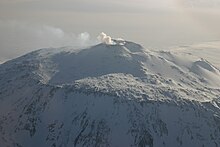
Antarctica is home to more than 70 lakes that lie at the base of the continental ice sheet. Lake Vostok, discovered beneath Russia's Vostok Station in 1996, is the largest of these subglacial lakes. It was once believed that the lake had been sealed off for 500,000 to one million years, but a recent survey suggests that, every so often, there are large flows of water from one lake to another.[69]
There is some evidence, in the form of ice cores drilled to about 400 m (1,300 ft) above the water line, that Lake Vostok's waters may contain microbial life. The frozen surface of the lake shares similarities with Jupiter's moon Europa. If life is discovered in Lake Vostok, it would strengthen the argument for the possibility of life on Europa.[70][71] In 2008, a NASA team embarked on a mission to Lake Untersee, searching for extremophiles in its highly alkaline waters. If found, highly resilient creatures could further bolster the argument for extraterrestrial life in extremely cold, methane-rich environments.[72]
In September 2018, researchers at the
Geology

From the end of the Neoproterozoic to the Cretaceous, Antarctica formed part of the supercontinent Gondwana.[75] Over time, Gondwana gradually broke apart, and Antarctica as we know it today was formed around 25 million years ago, when the Drake Passage opened between it and South America.[76] Antarctica was not always cold, dry, and covered in ice sheets. At a number of points in its history, it was farther north, experienced a tropical or temperate climate, and was covered in forests.[77]
Palaeozoic era (540–250 Ma)
During the
Mesozoic era (250–66 Ma)

As a result of continued warming, the polar ice caps melted and much of Gondwana became a desert. In Eastern Antarctica,
Gondwana breakup (160–23 Ma)
The cooling of Antarctica occurred stepwise, as the continental spread changed the oceanic currents from longitudinal equator-to-pole temperature-equalising currents to latitudinal currents that preserved and accentuated latitude temperature differences.
Africa separated from Antarctica in the Jurassic, around 160 Ma, followed by the Indian subcontinent in the early Cretaceous (about 125 Ma). By the end of the Cretaceous, about 66 Ma, Antarctica (then connected to Australia) still had a subtropical climate and flora, complete with a marsupial fauna.[94] In the Eocene epoch, about 40 Ma Australia-New Guinea separated from Antarctica, so that latitudinal currents could isolate Antarctica from Australia, and the first ice began to appear. During the Eocene–Oligocene extinction event about 34 million years ago, CO2 levels have been found to be about 760 ppm,[95] and had been decreasing from earlier levels in the thousands of ppm.[96]

Around 25 Ma, the Drake Passage opened between Antarctica and South America, resulting in the Antarctic Circumpolar Current that completely isolated the continent. Models of the changes suggest that declining CO2 levels became more important.[97] The ice began to spread, replacing the forests that until then had covered the continent. Since about 15 Ma, the continent has been mostly covered with ice.[98]
Pliocene and Pleistocene
Fossil Nothofagus leaves in the Meyer Desert Formation of the Sirius Group show that intermittent warm periods allowed Nothofagus shrubs to cling to the Dominion Range as late as 3–4 Ma (mid-late Pliocene).[99] After that, the Pleistocene ice age covered the whole continent and destroyed all major plant life on it.[100]
A study from 2014 estimated that during the Pleistocene, the East Antarctic Ice Sheet (EAIS) thinned by at least 500 m (1,600 ft), and that thinning since the Last Glacial Maximum for the EAIS area is less than 50 m (160 ft) and probably started after c. 14 ka.[101]
About 2,200 years ago, a volcano erupted under Antarctica's ice sheet, as detected by an airborne survey with radar images. The biggest eruption in Antarctica in the last 10,000 years, the volcanic ash was found deposited on the ice surface under the Hudson Mountains, close to Pine Island Glacier.[102]
Present-day
The geological study of Antarctica has been greatly hindered by nearly all of the continent being permanently covered with a thick layer of ice.[103] However, new techniques such as remote sensing, ground-penetrating radar and satellite imagery have begun to reveal the structures beneath the ice. Geologically, West Antarctica closely resembles the Andes mountain range of South America.[81] The Antarctic Peninsula was formed by uplift and metamorphism of sea bed sediments.[104]
The most common rocks in West Antarctica are andesite and rhyolite volcanics formed during the Jurassic period. There is also evidence of volcanic activity, even after the ice sheet had formed, in Marie Byrd Land and Alexander Island. The only anomalous area of West Antarctica is the Ellsworth Mountains region, where the stratigraphy is more similar to East Antarctica.[105]
East Antarctica is geologically varied, dating from the
The main mineral resource known on the continent is coal.
Climate
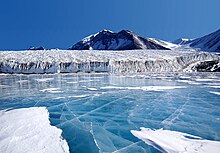

Antarctica is the coldest of Earth's continents. It was ice-free until about 34 million years ago, when it became covered with ice.[110] The lowest natural air temperature ever recorded on Earth was −89.2 °C (−128.6 °F) at the Russian Vostok Station in Antarctica on 21 July 1983.[111] A lower air temperature of −94.7 °C (−138.5 °F) was recorded in 2010 by satellite—however, it may have been influenced by ground temperatures and was not recorded at a height of 2 metres (7 ft) above the surface as required for official air temperature records.[112] Temperatures reach a minimum of between −80 °C (−112 °F) and −89.2 °C (−128.6 °F) in the interior in winter and reach a maximum of between 5 °C (41 °F) and 15 °C (59 °F) near the coast in summer. Northern Antarctica recorded a temperature of 19.8 °C (67.6 °F) on January 1982, the highest temperature ever recorded on the continent.[113]
Antarctica is a frozen desert with little precipitation; the South Pole receives less than 10 mm (0.4 in) per year, on average. Sunburn is often a health issue as the snow surface reflects almost all of the ultraviolet light falling on it. Given the latitude, long periods of constant darkness or constant sunlight create climates unfamiliar to human beings in much of the rest of the world.[114]
The
Regional climate
East Antarctica is colder than its western counterpart because of its higher elevation.
Antarctica is colder than the Arctic for three reasons. First, much of the continent is more than 3,000 m (9,800 ft) above sea level, and temperature decreases with elevation in the
Climate change
Some of Antarctica has been warming up; particularly strong warming has been noted on the Antarctic Peninsula. A study by Eric Steig published in 2009 noted for the first time that the continent-wide average surface temperature trend of Antarctica was slightly positive from 1957 to 2006.[116] Over the second half of the 20th century, the Antarctic Peninsula was the fastest-warming place on Earth, closely followed by West Antarctica, but these trends weakened in the early 21st-century.[117] Conversely, the South Pole in East Antarctica barely warmed last century, but temperatures shall have three times the global average in the last three decades.[118] In February 2020, the continent recorded its highest temperature of 18.3 °C (64.9 °F), which was a degree higher than the previous record of 17.5 °C (63.5 °F) in March 2015.[119]
There is some evidence that surface
In 2002 the Antarctic Peninsula's Larsen-B ice shelf collapsed.[123] Between 28 February and 8 March 2008, about 570 km2 (220 sq mi) of ice from the Wilkins Ice Shelf on the southwest part of the peninsula collapsed, putting the remaining 15,000 km2 (5,800 sq mi) of the ice shelf at risk. The ice was being held back by a "thread" of ice about 6 km (4 mi) wide,[124][125] prior to its collapse on 5 April 2009.[126][127]
Ice loss and global sea level
Due to its location at the South Pole, Antarctica receives relatively little solar radiation except along the southern summer. This means that it is a very cold continent where water is mostly in the form of ice. Precipitation is low (most of Antarctica is a desert) and almost always in the form of snow, which accumulates and forms the giant ice sheets which cover the continent.[128] Parts of this ice sheet form moving glaciers known as ice streams, which flow towards the edges of the continent.[129] Next to the continental shore are many ice shelves. These are floating extensions of outflowing glaciers from the continental ice mass. Offshore, temperatures are also low enough that ice is formed from seawater through most of the year.
Sea ice and ice shelves
Sea ice extent expands annually in the Antarctic winter, but most of this ice melts in the summer. This ice is formed from the ocean water and floats in the same water and thus does not contribute to a rise in sea level.[130] The extent of sea ice around Antarctica, in terms of square kilometres of coverage, has seen no significant trend in the satellite era (1978–2018), with initial growth being reversed in the last years of the record. A possible explanation for the difference between the Antarctic and the Arctic, which has seen rapid sea ice loss, is that thermohaline circulation transports warmed water to deeper layers in the ocean. The amount of variation it has experienced in its thickness is unclear with satellite techniques just emerging as of 2019.[131]
Melting of floating ice shelves (ice that originated on the land) does not in itself contribute much to sea-level rise, since the ice displaces only its own mass of water. However, ice sheets work as a stabilizer of the land ice, and are vulnerable to warming water. Recent decades have witnessed several dramatic collapses of large ice shelves around the coast of Antarctica, especially along the Antarctic Peninsula.[132] This loss of ice shelf ''buttressing'' has been identified as the major cause of ice loss on the West Antarctic ice sheet, but has also been observed around the East Antarctic ice sheet.[133]
Ice sheet loss and sea level rise

The Antarctic ice sheet is losing mass as ice flows faster into the ocean than before. This effect is partially offset by additional snow falling back onto the continent.[135] A 2018 systematic review study estimated that ice loss across the entire continent was 43 gigatonnes per year on average during the period from 1992 to 2002 but accelerated to an average of 220 gigatonnes per year during the five years from 2012 to 2017.[136] The total contribution to sea level rise has been estimated as 8 mm to 14 mm of sea level rise.[135][137]
On the continent itself, the large volume of ice present stores around 70% of the world's fresh water.[61] East Antarctica is a cold region with a ground base above sea level and occupies most of the continent. This area is dominated by small accumulations of snowfall which becomes ice and thus eventually seaward glacial flows. Estimates of the mass balance of the East Antarctic Ice Sheet as a whole range from slightly positive to slightly negative.[138][137] Increased ice outflow has been observed in some regions.[137]
Future projections of ice loss depend on the speed of climate change mitigation and are uncertain. Tipping points have been identified in some regions; when a certain threshold warming is reached, these regions may start melting significantly faster and irreversibly. That is, even when temperatures come down again, the ice will not immediately regrow.[139] [140]
Ozone depletion
There is a large area of low ozone concentration or "
Ozone depletion may have a dominant role in governing climatic change in Antarctica (and a wider area of the Southern Hemisphere).[142] Ozone absorbs large amounts of ultraviolet radiation in the stratosphere. Ozone depletion over Antarctica can cause a cooling of around 6 °C in the local stratosphere. This cooling has the effect of intensifying the westerly winds which flow around the continent (the polar vortex) and thus prevents outflow of the cold air near the South Pole. As a result, the continental mass of the East Antarctic ice sheet is held at lower temperatures, and the peripheral areas of Antarctica, especially the Antarctic Peninsula, are subject to higher temperatures, which promote accelerated melting.[142] Models suggest that ozone depletion and the enhanced polar vortex effect also account for the period of increased sea ice just offshore of the continent.[146][147]
Biodiversity
The terrestrial and native year-round species appear to be the descendants of ancestors who lived in geothermally warmed environments during the last ice age when these areas were the only places on the continent not covered by ice.[148]
Animals

Invertebrate life of Antarctica includes
Few terrestrial
A census of sea life carried out during the
Fungi
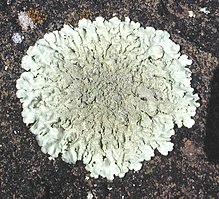
About 1,150 species of fungi have been recorded from Antarctica, of which about 750 are non-lichen-forming and 400 are lichen-forming.
Plants
About 300 million years ago Permian forests started to cover the continent, and tundra vegetation survived as late as 15 million years ago,[165] but the climate of present-day Antarctica does not allow extensive vegetation to form. A combination of freezing temperatures, poor soil quality, lack of moisture, and lack of sunlight inhibit plant growth. As a result, the diversity of plant life is very low and limited in distribution. The flora of the continent largely consists of bryophytes. There are about 100 species of mosses and 25 species of liverworts, but only three species of flowering plants, all of which are found in the Antarctic Peninsula: Deschampsia antarctica (Antarctic hair grass), Colobanthus quitensis (Antarctic pearlwort) and the non-native Poa annua (annual bluegrass).[166] Growth is restricted to a few weeks in the summer.[160][167]
Other organisms
Seven hundred species of algae exist, most of which are phytoplankton. Multicoloured snow algae and diatoms are especially abundant in the coastal regions during the summer.[167] Bacteria have been found living in the cold and dark as deep as 800 m (0.50 mi; 2,600 ft) under the ice.[168]
Conservation
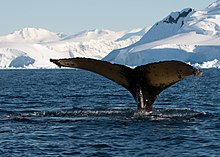
The Protocol on Environmental Protection to the Antarctic Treaty (also known as the Environmental Protocol or Madrid Protocol) came into force in 1998, and is the main instrument concerned with conservation and management of biodiversity in Antarctica. The Antarctic Treaty Consultative Meeting is advised on environmental and conservation issues in Antarctica by the Committee for Environmental Protection. A major concern within this committee is the risk to Antarctica from unintentional introduction of non-native species from outside the region.[169]
The passing of the Antarctic Conservation Act (1978) in the U.S. brought several restrictions to U.S. activity on Antarctica. The introduction of alien plants or animals can bring a criminal penalty, as can the extraction of any indigenous species. The overfishing of krill, which plays a large role in the Antarctic ecosystem, led officials to enact regulations on fishing. The Convention for the Conservation of Antarctic Marine Living Resources (CCAMLR), a treaty that came into force in 1980, requires that regulations managing all Southern Ocean fisheries consider potential effects on the entire Antarctic ecosystem.[1] Despite these new acts, unregulated and illegal fishing, particularly of Patagonian toothfish (marketed as Chilean Sea Bass in the U.S.), remains a serious problem. The illegal fishing of toothfish has been increasing, with estimates of 32,000 tonnes (35,000 short tons) in 2000.[170][171][needs update]
Population
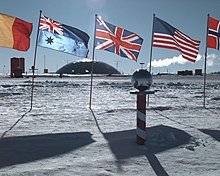
Several governments maintain permanent, staffed research stations on the continent. The number of people conducting and supporting scientific research and other work on the continent and its nearby islands varies from about 1,000 in winter to about 5,000 in the summer, giving it a population density between 70 and 350 inhabitants per million square kilometres (180 and 900 per million square miles) at these times. Many of the stations are staffed year-round, the winter-over personnel typically arriving from their home countries for a one-year assignment. An Orthodox church—Trinity Church, opened in 2004 at the Russian Bellingshausen Station—is manned year-round by one or two priests, who are similarly rotated every year.[172][173]
The first semi-permanent inhabitants of regions near Antarctica (areas situated south of the Antarctic Convergence) were British and American sealers who used to spend a year or more on South Georgia, from 1786 onward. During the whaling era, which lasted until 1966, the population of that island varied from over 1,000 in the summer (over 2,000 in some years) to some 200 in the winter. Most of the whalers were Norwegian, with an increasing proportion of Britons. The settlements included Grytviken, Leith Harbour, King Edward Point, Stromness, Husvik, Prince Olav Harbour, Ocean Harbour and Godthul. Managers and other senior officers of the whaling stations often lived together with their families. Among them was the founder of Grytviken, Captain Carl Anton Larsen, a prominent Norwegian whaler and explorer who, along with his family, adopted British citizenship in 1910.[174]
Politics
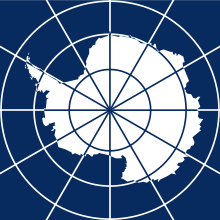
Several countries claim sovereignty in certain regions. While a few of these countries have mutually recognised each other's claims,[182] the validity of these claims is not recognised universally.[1]
New claims on Antarctica have been suspended since 1959, although in 2015 Norway formally defined Queen Maud Land as including the unclaimed area between it and the South Pole.
Military activities banned
The Antarctic Treaty bans military activity on Antarctica. This was the first arms control agreement established during the Cold War.
The Antarctic Treaty prohibits any
Environmental protection
A coalition of international environmental protection organisations
In 1983 the Antarctic Treaty Parties began negotiations on a convention to regulate
Antarctic territories
| Date | Claimant | Territory | Claim limits | Map |
|---|---|---|---|---|
| 1840 | 142°02′E to 136°11′E | 
| ||
| 1908 | 080°00′W to 020°00′W including overlaps:
|

| ||
| 1923 | 160°00′E to 150°00′W | 
| ||
| 1931 | 68°50′S 90°35′W / 68.833°S 90.583°W | 
| ||
| 1933 | 044°38′E to 136°11′E, and 142°02′E to 160°00′E | 
| ||
| 1939 | 020°00′W to 044°38′E | 
| ||
| 1940 | 090°00′W to 053°00′W including overlaps:
|

| ||
| 1943 | 074°00′W to 025°00′W including overlaps:
|

| ||
| – | (Unclaimed territory) | 150°00′W to 090°00′W (except Peter I Island) |

|
The Argentine, British and Chilean claims all overlap, and have caused friction. On 18 December 2012, the British
The areas shown as Australia's and New Zealand's claims were British territory until they were handed over following the countries' independence. Australia currently claims the largest area. The claims of Britain, Australia, New Zealand, France and Norway are all recognised by each other.[199]
Other countries participating as members of the Antarctic Treaty have a territorial interest in Antarctica, but the provisions of the Treaty do not allow them to make their claims while it is in force.[200][201]
 Brazil has a designated "zone of interest" that is not an actual claim.[202]
Brazil has a designated "zone of interest" that is not an actual claim.[202] Peru has formally reserved its right to make a claim.[200][201]
Peru has formally reserved its right to make a claim.[200][201] Russia has inherited the Soviet Union's right to claim territory under the original Antarctic Treaty.[203]
Russia has inherited the Soviet Union's right to claim territory under the original Antarctic Treaty.[203] South Africa has formally reserved its right to make a claim.[200][201]
South Africa has formally reserved its right to make a claim.[200][201] United States reserved its right to make a claim in the original Antarctic Treaty.[203]
United States reserved its right to make a claim in the original Antarctic Treaty.[203]
Economy

There is no current economic activity in Antarctica outside of fishing off the coast and small-scale tourism.[1]
Although coal, hydrocarbons, iron ore, platinum, copper, chromium, nickel, gold and other minerals have been found, they have not been in large enough quantities to exploit.[204] The 1991 Protocol on Environmental Protection to the Antarctic Treaty also restricts a struggle for resources. In 1998, a compromise agreement was reached to place an indefinite ban on mining, to be reviewed in 2048, further limiting economic development and exploitation. The primary economic activity is the capture and offshore trading of fish. Antarctic fisheries in 2000–01 reported landing 112,934 tonnes.[205]
Small-scale "expedition tourism" has existed since 1957 and is currently subject to Antarctic Treaty and Environmental Protocol provisions, but in effect self-regulated by the International Association of Antarctica Tour Operators (IAATO). Not all vessels associated with Antarctic tourism are members of IAATO, but IAATO members account for 95% of the tourist activity. Travel is largely by small or medium ship, focusing on specific scenic locations with accessible concentrations of iconic wildlife. A total of 37,506 tourists visited during the 2006–07 Austral summer with nearly all of them coming from commercial ships; 38,478 were recorded in 2015–16.[206][207][208] As of 2018, there are two Wells Fargo ATMs in Antarctica, both located at McMurdo Station.[209]
There has been some concern over the potential adverse environmental and ecosystem effects caused by the influx of visitors. Some environmentalists and scientists have made a call for stricter regulations for ships and a tourism quota.
About thirty countries maintain about seventy research stations (40-year-round or permanent, and 30 summer-only) in Antarctica, with an approximate population of 4000 in summer and 1000 in winter.[1]
The
Research

Each year, scientists from 28 nations conduct experiments not reproducible in any other place in the world. In the summer more than 4,000 scientists operate research stations; this number decreases to just over 1,000 in the winter.[1] McMurdo Station, which is the largest research station in Antarctica, is capable of housing more than 1,000 scientists, visitors, and tourists.[215]
Researchers include biologists, geologists, oceanographers, physicists, astronomers, glaciologists, and meteorologists. Geologists tend to study plate tectonics, meteorites from outer space, and resources from the breakup of the supercontinent Gondwana. Glaciologists in Antarctica are concerned with the study of the history and dynamics of floating ice, seasonal snow, glaciers, and ice sheets. Biologists, in addition to examining the wildlife, are interested in how harsh temperatures and the presence of people affect adaptation and survival strategies in a wide variety of organisms.[216] Medical physicians have made discoveries concerning the spreading of viruses and the body's response to extreme seasonal temperatures.[217]
Since the 1970s an important focus of study has been the
In 2007,
Astrophysics
This large collection of meteorites allows a better understanding of the abundance of meteorite types in the solar system and how meteorites relate to asteroids and comets. New types of meteorites and rare meteorites have been found. Among these are pieces blasted off the Moon and Mars by impacts. These specimens, particularly
Notes
- ^ The word was originally pronounced with the first c silent in English, but the spelling pronunciation has become common and is often considered more correct. The pronunciation with a silent c, and even with the first t silent as well, is however widespread and typical of many similar English words.[2] The c had ceased to be pronounced in Medieval Latin and was dropped from the spelling in Old French, but it was added back for etymological reasons in English in the 17th century and thereafter began to be pronounced, but (as with other spelling pronunciations) at first only by less educated people.[3][4] For those who pronounce the first t, there is also variation between the pronunciations Ant-ar(c)tica and An-tar(c)tica.
References
- ^ a b c d e f g h i j United States Central Intelligence Agency (2011). "Antarctica". The World Factbook. Government of the United States. Retrieved 14 September 2017.
- ^ Antarctica Archived 8 December 2015 at the Wayback Machine. American Heritage Dictionary
- ISBN 978-0-19-920764-0.
- ^ Harper, Douglas. "Antarctic". Online Etymology Dictionary. Retrieved 16 November 2011.
- doi:10.5194/tc-7-375-2013. Retrieved 6 January 2014.)
{{cite journal}}: CS1 maint: unflagged free DOI (link - ^ a b Cain, Fraser (12 June 2008). "What is the Driest Place on Earth?". Universe Today. Retrieved 12 April 2021.
- ^ "La Antártida" (in Spanish). Dirección Nacional del Antártico. Archived from the original on 13 November 2016. Retrieved 13 November 2016.
- ^ Joyce, C. Alan (18 January 2007). "The World at a Glance: Surprising Facts". The World Almanac. Archived from the original on 4 March 2009. Retrieved 7 February 2009.
- ^ "Coldest temperature ever recorded on Earth in Antarctica: -94.7C (−135.8F)". The Guardian. Associated Press. 10 December 2013. Retrieved 12 July 2017.
- ^ Liddell, Henry George; Scott, Robert. "Antarktikos". In Crane, Gregory R. (ed.). A Greek–English Lexicon. Perseus Digital Library. Tufts University. Retrieved 18 November 2011.
- ISBN 978-0-9577471-1-1.
- ^ "Did you know that the term Antarctic actually comes from "anti-Arctic"? | South Pole 1911-2011". nettarkiv.npolar.no. Retrieved 7 April 2021.
- ^ Aristotle Meteorologica. Book II, Part 5. 350 BCE. Translated by E. Webster. Oxford: Clarendon Press, 1923. 140 pp.
- ^ "Pioneers: British Antarctic Expedition 1910—1913" (PDF). United Kingdom Meteorological Office. 2012. Retrieved 8 March 2021.
- ^ Hyginus. De astronomia. Ed. G. Viré. Stuttgart: Teubner, 1992. 176 pp.
- ^ Apuleii. Opera omnia. Volumen tertium. London: Valpy, 1825. 544 pp.
- ^ G. Chaucer. A Treatise on the Astrolabe. Approx. 1391. Ed. W. Skeat. London: N. Trübner, 1872. 188 pp.
- ^ Matthias Ringmann, De Ora antarctica per regem Portugallie pridem inventa [The antarctic country discovered some time since by the King of Portugal], Strassburg, 1505.[1]
- ^ Barth, Cyriaco Jacob zum (1545). Astronomia: Teutsch Astronomei. Frankfurt.
- ISBN 978-0-6480439-6-6.
- ^ John George Bartholomew and the naming of Antarctica, CAIRT Issue 13, National Library of Scotland, July 2008, ISSN 1477-4186, and also "The Bartholomew Archive".
- ^ "Resource Library: Antarctica". National Geographic. 4 January 2012. Retrieved 31 August 2020.
- ^ .
- ^ Smith, Stephenson Percy (1899). Hawaiki: the whence of the Maori, being an introduction to Rarotongan history: Part III. The Journal of the Polynesian Society, Volume 8. pp. 10–11. Retrieved 21 November 2019.
- ^ Henriques, Martha. "The bones that could shape Antarctica's fate". BBC Future. Retrieved 22 July 2021.
- ^ Flinders, Matthew (1814). A voyage to Terra Australis. Introduction: G. and W. Nicol. Archived from the original on 11 November 2012. Retrieved 25 January 2013.
- ^ "Age of Exploration: John Cook". The Mariners' Museum. Archived from the original on 7 February 2006. Retrieved 12 February 2006.
- ISBN 9780141928081.
- ISBN 978-1-4724-5324-2.
- ^ U.S. Antarctic Program External Panel of the National Science Foundation. "Antarctica—Past and Present" (PDF). Government of the United States. Archived (PDF) from the original on 17 February 2006. Retrieved 6 February 2006.
- ^ Guthridge, Guy G. "Nathaniel Brown Palmer, 1799–1877". Government of the United States, National Aeronautics and Space Administration. Archived from the original on 2 February 2006. Retrieved 6 February 2006.
- ^ "Palmer Station". University of the City of San Diego. Archived from the original on 10 February 2006. Retrieved 3 March 2008.
- ^ "Экспозиции: Антарктика" [Exhibition: Antarctica]. Polar Museum (in Russian).
- ^ "An Antarctic Time Line: 1519–1959". South-Pole.com. Archived from the original on 10 February 2006. Retrieved 12 February 2006.
- ^ "Antarctic Explorers Timeline: Early 1800s". Polar Radar for Ice Sheet Measurements (PRISM). Retrieved 12 February 2006.
- ISBN 978-1577853589.
- ^ Erki Tammiksaar (14 December 2013). "Punane Bellingshausen" [Red Bellingshausen]. Postimees.Arvamus. Kultuur (in Estonian).
- .
- ISBN 978-1-86397-584-1.
- ^ Joyner, Christopher C. (1992). Antarctica and the Law of the Sea. Martinus Nijhoff Publishers. p. 5.
- ISBN 978-1-74126-127-1.
- ^ "Proposition de classement du rocher du débarquement dans le cadre des sites et monuments historiques" (in French). Antarctic Treaty Consultative meeting 2006, note 4.
- ^ "Voyage au Pôle sud et dans l'Océanie sur les corvettes "l'Astrolabe" et "la Zélée", exécuté par ordre du Roi pendant les années 1837-1838-1839-1840 sous le commandement de M.J. Dumont-d'Urville, capitaine de vaisseau" (in French). Vol. 8. Paris: Gide publisher. 1842–1846. pp. 149–152. gallica.bnf.fr, BNF.
- ^ "South-Pole – Exploring Antarctica". South-Pole.com. Archived from the original on 14 February 2006. Retrieved 12 February 2006.
- ^ "Antarctic Circle – Antarctic First". 9 February 2005. Archived from the original on 8 February 2006. Retrieved 12 February 2006.
- ^ "Tannatt William Edgeworth David". Australian Antarctic Division. Archived from the original on 29 September 2010. Retrieved 27 September 2010.
- ^ "Roald Amundsen". South-Pole.com. Archived from the original on 5 February 2006. Retrieved 9 February 2006.
- ^ Cunningham, Robert; Jatko, Joyce (1998). Amundsen-Scott South Pole Station, Proposal to Modernize Through Reconstruction and Replacement of Key Facilities. National Science Foundation. p. 7.
- ^ "Richard Byrd". 70South.com. Archived from the original on 11 October 2007. Retrieved 12 February 2006.
- ^ "Women in Antarctica: Sharing this Life-Changing Experience" Archived 10 March 2012 at the Wayback Machine, transcript of speech by Robin Burns, given at the 4th Annual Phillip Law Lecture; Hobart, Tasmania, Australia; 18 June 2005. Retrieved 5 August 2010.
- ^ "The first woman in Antarctica". www.antarctica.gov.au. Australian Antarctic Division. 2012. Retrieved 27 June 2016.
- ^ Blackadder, Jesse (October 2013). Illuminations : casting light upon the earliest female travellers to Antarctica (Doctor of Creative Arts). University of Western Sydney.
- ^ Bogen, H. (1957). Main events in the history of Antarctic exploration. Sandefjord: Norwegian Whaling Gazette, page 85
- ^ "Dates in American Naval History: October". Naval History and Heritage Command. United States Navy. Archived from the original on 26 June 2004. Retrieved 12 February 2006.
- ^ "First Women at Pole". South Pole Station. Retrieved 24 August 2016.
- ISSN 0261-3077. Retrieved 30 December 2018.
- ^ "O'Brady's Antarctic Crossing: Was It Really Unassisted?". Explorersweb. Retrieved 29 December 2018.
- ^ "Fastest unsupported (kite assisted) journey to the South Pole taking just 34 days". Guinness World Records.
- ISBN 978-0-901021-04-5.
- ^ Lotha, Gloria; et al. (20 July 1998). "Transantarctic Mountains". Encyclopedia Britannica. Retrieved 8 February 2021.
- ^ a b "How Stuff Works: polar ice caps". howstuffworks.com. 21 September 2000. Archived from the original on 4 February 2006. Retrieved 12 February 2006.
- doi:10.1002/joc.1933. Retrieved 12 October 2020 – via Wiley Online Library.
- S2CID 154732005. Retrieved 4 February 2021.
- ^ Hallberg, Robert; Sergienko, Olga (2019). "Ice Sheet Dynamics". Geophysical Fluid Dynamics Laboratory. Retrieved 7 February 2021.
- ISBN 9780080931616.
- ISBN 9780938567424.
- ^ British Antarctic Survey. "Volcanoes". Natural Environment Research Council. Archived from the original on 11 July 2007. Retrieved 13 February 2006.
- ^ "Scientists Discover Undersea Volcano Off Antarctica". United States National Science Foundation. Retrieved 13 February 2006.
- ^ Briggs, Helen (19 April 2006). "Secret rivers found in Antarctic". BBC News. Retrieved 7 February 2009.
- ^ "Lake Vostok". United States National Science Foundation. Retrieved 13 February 2006.
- ^ Abe, Shige; Bortman, Henry (13 April 2001). "Focus on Europa". NASA. Archived from the original on 19 October 2014. Retrieved 12 January 2012.
- ^ Coulter, Dana. Tony Phillips (ed.). "Extremophile Hunt Begins". Science News. NASA. Archived from the original on 23 March 2010. Retrieved 22 October 2011.
- ^ Stirone, Shannon (7 September 2018). "New Antarctica Map Is Like 'Putting on Glasses for the First Time and Seeing 20/20' – A high resolution terrain map of Earth's frozen continent will help researchers better track changes on the ice as the planet warms". The New York Times. Retrieved 9 September 2018.
- ^ "Reference Elevation Model of Antarctica". Polar Geospatial Center. Retrieved 2 February 2021.
- ^ Browne, Malcolm W.; et al. (1995). Antarctic News Clips. National Science Foundation. p. 109. Retrieved 2 February 2021.
- ISBN 9781853687433. Retrieved 2 February 2021.
- S2CID 214736648.
- ISBN 9780813721941.
- .
- ^ ISBN 978-1-139-02499-0.
- ^ ISBN 978-0-471-98665-2.
- ^ a b J.W. Collinson, W.R. Hammer Migration of Triassic tetrapods to Antarctica A.K. Cooper, C.R. Raymond, et al. (Eds.), Antarctica: A Keystone in a Changing World — Online Proceedings of the 10th ISAES X, USGS Open-File Report 2007-1047, Extended Abstract, 047 (2007) (3 pp.)
- ISBN 9783110341553.
- ISBN 9789400768413.
- doi:10.1007/BF00210547 (inactive 31 May 2021).)
{{cite journal}}: CS1 maint: DOI inactive as of May 2021 (link - ISBN 9781139560283.
- S2CID 131433262.
- ISBN 9780415970242.
- ^ Smith, Nathan D.; Pol, Diego (2007). "Anatomy of a basal sauropodomorph dinosaur from the Early Jurassic Hanson Formation of Antarctica" (PDF). Acta Palaeontologica Polonica. 52 (4): 657–674.
- .
- .
- .
- ^ Leslie, Mitch (December 2007). "The Strange Lives of Polar Dinosaurs". Smithsonian Magazine. Archived from the original on 30 January 2008. Retrieved 24 January 2008.
- ^ Reinhold, Robert (21 March 1982). "Antarctica yields first land mammal fossil". The New York Times.
- ^ "New CO2 data helps unlock the secrets of Antarctic formation". Physorg.com. Archived from the original on 15 July 2011. Retrieved 26 July 2011.
- ISBN 9780521871648.
- S2CID 4326971.
- ^ ISBN 978-1-55297-590-9.
- S2CID 128906475.
- ^ Weisburd, Stefi (March 1986). "A forest grows in Antarctica. (an extensive forest may have flourished about 3 million years ago)". Science News. Retrieved 2 November 2012.
- .
- ^ Black, Richard (20 January 2008). "Ancient Antarctic eruption noted". BBC News. Archived from the original on 15 January 2009. Retrieved 7 February 2009.
- ^ "Antarctica's geology". Royal Geographical Society (with the Institute of British Geographers) in partnership with the British Antarctic Survey and the Foreign and Commonwealth Office. Archived from the original on 22 November 2014. Retrieved 31 October 2014.
- ISBN 9780195577075.
- JSTOR 2417757– via JSTOR.
- ISSN 0166-2481– via Elsevier.
- . Retrieved 4 February 2021.
- . Retrieved 4 February 2021.
- ^ Dodds, Klaus (12 July 2018). "In 30 years the Antarctic Treaty becomes modifiable, and the fate of a continent could hang in the balance". The Conservation.
- S2CID 206644221.
- ISSN 2156-2202.
- ^ Rice, Doyle (10 December 2013). "Antarctica records unofficial coldest temperature ever". USA Today.
- ^ "WMO verifies one temperature record for Antarctic continent and rejects another". World Meteorological Organization. 1 July 2021. Archived from the original on 2 July 2021. Retrieved 3 July 2021.
- ^ a b "Weather in the Antarctic". British Antarctic Survey. Natural Environment Research Council. Retrieved 9 February 2006.
- ^ The Earth's Elliptical Orbit Around the Sun – Aphelion and Perihelion. Geography.about.com. Retrieved on 21 October 2013.
- S2CID 4410477.
- S2CID 220260051.
- S2CID 220261150.
- ^ Larson, Christina (8 February 2020). "Antarctica appears to have broken a heat record". Phys.org. Retrieved 9 February 2020.
- doi:10.1038/ngeo338.
- hdl:2060/20150001452.
- ^ Meredith, M.; Sommerkorn, M.; Cassotta, S.; Derksen, C.; et al. (2019). "Chapter 3: Polar Regions" (PDF). IPCC Special Report on the Ocean and Cryosphere in a Changing Climate. p. 212.
- ^ Glasser, Neil (10 February 2008). "Antarctic Ice Shelf Collapse Blamed on More Than Climate Change". ScienceDaily.
- ^ "Huge Antarctic ice chunk collapses". CNN. Associated Press. 25 March 2008. Archived from the original on 29 March 2008. Retrieved 25 March 2008.
- ^ Walton, Marsha (25 March 2008). "Massive ice shelf on verge of breakup". CNN. Archived from the original on 29 March 2008. Retrieved 26 March 2008.
- ^ "Ice Bridge Holding Antarctic Shelf in Place Shatters". The New York Times. Reuters. 5 April 2009. Archived from the original on 16 April 2009. Retrieved 5 April 2009.
- ^ "Ice bridge ruptures in Antarctic". BBC News. 5 April 2009. Archived from the original on 6 April 2009. Retrieved 5 April 2009.
- ISBN 9780565092177.
- OCLC 487165.
- ^ Scott, Michon (28 April 2020). "Understanding climate: Antarctic sea ice extent". NOAA Climate.gov. Retrieved 1 February 2021.
- ^ Meredith, M.; Sommerkorn, M.; Cassotta, S.; Derksen, C.; et al. (2019). "Chapter 3: Polar Regions" (PDF). IPCC Special Report on the Ocean and Cryosphere in a Changing Climate. p. 214.
- doi:10.1029/2004GL020697. Archived from the original(PDF) on 23 November 2011. Retrieved 22 October 2011.
- ^ Oppenheimer, M.; Glavovic, B.; Hinkel, J.; van de Wal, R.; et al. (2019). "Chapter 4: Sea Level Rise and Implications for Low Lying Islands, Coasts and Communities" (PDF). IPCC Special Report on the Ocean and Cryosphere in a Changing Climate. Intergovernmental Panel on Climate Change. pp. 346–347.
- ^ "Facts / Vital signs / Ice Sheets / Antarctica Mass Variation Since 2002". NASA. 2020. Archived from the original on 9 December 2020.
- ^ S2CID 213191762.
- S2CID 49188002.)
{{cite journal}}: Unknown parameter|lay-date=ignored (help); Unknown parameter|lay-source=ignored (help); Unknown parameter|lay-url=ignored (help - ^ PMID 30642972.
- ISSN 1944-8007.
- S2CID 213191697.
- ^ Porterfield, Carlie (28 April 2021). "One Of Antarctica's Largest Ice Shelves Is About To Collapse, New Study Says". Forbes.
- ^ a b Bates, Sofie (30 October 2020). "Large, Deep Antarctic Ozone Hole Persisting into November". NASA. Retrieved 6 February 2021.
- ^ PMID 19675624.
- ^ "Record-breaking 2020 ozone hole closes". World Meteorological Organization. 6 January 2021. Retrieved 6 February 2021.
- ^ National Aeronautics and Space Administration, Advanced Supercomputing Division (NAS) (26 June 2001). "The Antarctic Ozone hole". Government of the United States. Archived from the original on 3 April 2009. Retrieved 7 February 2009.
- ^ "Ozone hole set to close". Space Daily. Space Media Network. 12 November 2019. Retrieved 8 December 2019.
- .
- S2CID 209935487.
- ^ Fraser, Ceridwen (11 March 2014). "Antarctic volcanoes help preserve life in the freezer". The Conversation.
- ^ Sandro, Luke; Constible, Juanita. "Antarctic Bestiary – Terrestrial Animals". Laboratory for Ecophysiological Cryobiology, Miami University. Retrieved 22 October 2011.
- PMID 28327954.
- ^ Boopendranath, M.R. (February 2013). "Antarctic krill - a keystone species of Antarctica". Science India. Retrieved 8 March 2021.
- ^ British Antarctic Survey. "Land Animals of Antarctica". Natural Environment Research Council. Archived from the original on 7 October 2008. Retrieved 25 April 2017.
- PMID 23537764. Retrieved 12 October 2020 – via Elsevier Science Direct.
- ^ "Snow Petrel Pagodroma nivea". BirdLife International. Retrieved 20 October 2009.
- ISBN 9780717259465.
- ISBN 9784938424329.
- ^ "Weddell Seal". Oceanwide Expeditions. Retrieved 8 March 2021.
- PMID 29870541.)
{{cite journal}}: CS1 maint: unflagged free DOI (link - ^ Kinver, Mark (15 February 2009). "Ice oceans 'are not poles apart'". BBC News. British Broadcasting Corporation. Retrieved 22 October 2011.
- ^ a b British Antarctic Survey. "Plants of Antarctica". Natural Environment Research Council. Archived from the original on 7 June 2011. Retrieved 12 July 2011.
- ^ Bridge, Paul D.; Spooner, Brian M.; Roberts, Peter J. (2008). "Non-lichenized fungi from the Antarctic region". Mycotaxon. 106: 485–490. Archived from the original on 11 August 2013. Retrieved 22 October 2011.
- ^ Selbmann, L; de Hoog, G S; Mazzaglia, A; Friedmann, E. I.; Onofri, S (2005). "Fungi at the edge of life: cryptoendolithic black fungi from Antarctic desert" (PDF). Studies in Mycology. 51: 1–32.
- ^ Onofri, S.; Selbmann, L.; Zucconi, L.; Scalzi, G.; Venkateswaran, K.J.; de la Torre, R.; de Vera, J.-P.; Ott, S.; Rabbow, E. & Horneck, G. "Survival of Black Fungi in Space, Preliminary Results" (PDF). Retrieved 13 March 2013.
- ^ de Hoog, G.S. (2005). "Fungi of the Antarctic: evolution under extreme conditions". Studies in Mycology. 51: 1–79.
- ^ "Antarctica was once green: Scientists". Telangana Today. IASN. 15 April 2017. Archived from the original on 23 April 2017.
- S2CID 84747627.
- ^ a b Australian Antarctic Division. "Antarctic Wildlife". Government of Australia. Archived from the original on 28 August 2010. Retrieved 27 September 2010.
- ^ Gorman, James (6 February 2013). "Bacteria Found Deep Under Antarctic Ice, Scientists Say". The New York Times. Retrieved 6 February 2013.
- ^ Bridge, Paul D.; Hughes, Kevin. A. (2010). "Conservation issues for Antarctic fungi". Mycologia Balcanica. 7 (1): 73–76. Archived from the original on 11 August 2013. Retrieved 12 July 2011.
- ^ Kirby, Alex (15 August 2001). "Toothfish at risk from illegal catches". BBC News. Retrieved 22 October 2011.
- ^ "Toothfish". Australian Antarctic Division. Retrieved 22 October 2011.
- ^ "Flock of Antarctica's Orthodox temple celebrates Holy Trinity Day". Serbian Orthodox Church. 24 May 2004. Retrieved 7 February 2009.
- ^ Владимир Петраков: 'Антарктика – это особая атмосфера, где живут очень интересные люди' [Vladimir Petrakov: "Antarctic is a special world, full of very interesting people"]. Pravoslavye (in Russian). 28 April 2021.
- ISBN 0521252741.
- OCLC 473919719.
- ISBN 978-0806947686.
- ^ Old Antarctic Explorers Association. "THIS QUARTER IN HISTORY" (PDF). Explorer's Gazette. 9 (1): 9. Retrieved 3 December 2019.
- ^ Bone, James (13 November 2007). "The power games that threaten world's last pristine wilderness". The Times.
- ^ "Questions to the Sun for the 2002–03 season". The Antarctic Sun. Archived from the original on 11 February 2006. Retrieved 9 February 2006.
- ^ "Registro Civil Base Esperanza" (in Spanish). Argentine Army. 22 December 2017. Archived from the original on 17 January 2010.
- ^ Corporación de Defensa de la Soberanía. "Derechos soberanos antárticos de Chile" (in Spanish). Retrieved 16 November 2011.
- reciprocally recognize the validity of each other's claims."
- ^ Rapp, Ole Magnus (21 September 2015). "Norge utvider Dronning Maud Land helt frem til Sydpolen". Aftenposten (in Norwegian). Oslo, Norway. Retrieved 22 September 2015.
... formålet med anneksjonen var å legge under seg det landet som til nå ligger herreløst og som ingen andre enn nordmenn har kartlagt og gransket. Norske myndigheter har derfor ikke motsatt seg at noen tolker det norske kravet slik at det går helt opp til og inkluderer polpunktet.
- ^ "Antarctic Treaty System – Parties". Antarctic Treaty and the Secretariat. Retrieved 20 October 2009.
- ^ "Antarctic Treaty". Scientific Committee on Antarctic Research. Archived from the original on 6 February 2006. Retrieved 9 February 2006.
- Antarctica Institute of Argentina. Archived from the originalon 6 March 2006. Retrieved 9 February 2006.
- ^ "Antarctic and Southern Ocean Coalition". Antarctic and Southern Ocean Coalition. Archived from the original on 25 July 2011. Retrieved 26 July 2011.
- ^ "World Park Antarctica". Greenpeace.org. Greenpeace International. 25 February 2010. Archived from the original on 15 March 2010. Retrieved 26 July 2011.
- ^ "Greenpeace applauds Antarctic protection victory" (Press release). Greenpeace International. 14 January 1998. Archived from the original on 20 February 2006.
- ^ "Antarctica: exploration or exploitation?". New Scientist. 22 June 1991.
- ^ "Mining Issues in Antarctica" (PDF). Antarctica New Zealand. Archived from the original (PDF) on 10 May 2005. Retrieved 1 September 2003.
- ^ "Antarctica, a tale of two treaties". New Scientist. Retrieved 27 May 2008.
- ^ a b "The Madrid Protocol". Australian Antarctic Division. Retrieved 22 October 2011.
- ^ Bobo, Jack A. "Antarctic Treaty Papers". Archived from the original on 23 May 2011. Retrieved 19 October 2009.
- ^ "Protocol on Environmental Protection To The Antarctic Treaty (The Madrid Protocol)". Australian Antarctic Programme. 17 May 2019. Retrieved 8 February 2021.
- ^ "The Foreign Secretary has announced that the southern part of British Antarctic Territory has been named Queen Elizabeth Land". Foreign & Commonwealth Office. HM Government. 18 December 2012. Retrieved 22 December 2012.
- ^ "Argentina angry after Antarctic territory named after Queen". BBC News. 22 December 2012. Retrieved 22 December 2012.
- ^ "Argentina 'will control Falklands within 20 years'". BBC News. 5 February 2013. Retrieved 26 April 2021.
- ISBN 0-7546-4419-7.
- ^ a b c "La Antartica". Library.jid.org. Archived from the original on 7 October 2008. Retrieved 4 November 2008.
- ^ a b c Afese.com Archived 7 July 2011 at the Wayback Machine. (PDF) . Retrieved on 19 July 2011.
- ISBN 978-0-7923-0181-3.
... Brazil has even designated a zone of Antarctic interest that overlaps the Argentine sector but not the Chilean one ...
- ^ a b "Disputes – international". The World Factbook. United States Central Intelligence Agency. 2011. Retrieved 22 October 2011.
... the US and Russia reserve the right to make claims ...
- ^ "Natural Resources". The World Factbook. CIA. Retrieved 30 October 2016.
- ^ "Fisheries News". mecropress. 30 November 2003. Retrieved 30 October 2016.
- Antarctic Treaty Secretariat. Archived from the original(DOC) on 8 August 2007. Retrieved 2 August 2007.
- ^ "Politics of Antarctica". Archived from the original on 14 February 2005. Retrieved 5 February 2006.
- ^ "2015–2016 Tourists by Nationality Total". IAATO. Archived from the original on 10 November 2016. Retrieved 30 January 2017.
- ISBN 9781760783471.
- ^ Rowe, Mark (11 February 2006). "Tourism threatens Antarctic". London: Telegraph UK. Archived from the original on 24 February 2008. Retrieved 5 February 2006.
- ^ Erceg 2017, p. 36
- ^ Erceg 2017, p. 120
- ^ see ISO 4217
- ^ Symes, Peter (2002). "Private Issues – The Antarctica Issues and the NORFED Issues". Retrieved 22 November 2016.
- S2CID 132258248– via Cambridge Core.
- – via Elsevier Science Direct.
- ^ "Human Biology and Medicine". Australian Antarctic Programme. 16 September 2020. Retrieved 8 February 2021.
- hdl:1721.1/99159– via MIT Open Access Articles.
- ^ Graham, Rex (15 July 2014). "Adelie Penguins thriving amid Antarctica's melting ice". Archived from the original on 5 June 2016. Retrieved 24 October 2014.
- ^ Rejcek, Peter (2 December 2013). "Polar Geospatial Center Releases New Application with High-Res Satellite Imagery". The Antarctic Sun. Retrieved 24 October 2014.
- ^ Belgian Science Policy Office Archived 4 July 2007 at the Wayback Machine – Princess Elisabeth Station
- ^ "Science in Antarctica". Antarctic Connection. Archived from the original on 7 February 2006. Retrieved 4 February 2006.
- ^ a b "Meteorites from Antarctica". NASA. Archived from the original on 6 March 2006. Retrieved 9 February 2006.
Bibliography
- Erceg, Diane (October 2017). "Explorers of a Different Kind: A History of Antarctic Tourism 1966–2016" (PDF). Australian National University.
- J. Stewart. Antarctica: An Encyclopedia. Jefferson, N.C. and London: McFarland, 2011. 1771 pp. ISBN 978-0-7864-3590-6
- B. Riffenburgh, ed. Encyclopedia of the Antarctic. New York, N.Y.: Routledge, 2006. 1272 pp. ISBN 978-1-1358-7866-5
External links
- High resolution map (2018) – Reference Elevation Model of Antarctica (REMA)
- Antarctica. on In Our Time at the BBC
- Antarctica. The World Factbook. Central Intelligence Agency.
- Antarctic Treaty Secretariat, de facto government
- British Antarctic Survey (BAS)
- U.S. Antarctic Program Portal
90°S 0°E / 90°S 0°E Template:Featured article is only for Wikipedia:Featured articles.
Category:Antarctic region Category:Continents Category:Demilitarized zones Category:Extreme points of Earth Category:Polar regions of the Earth Category:Articles containing video clips Category:Geographical articles missing image alternative text

